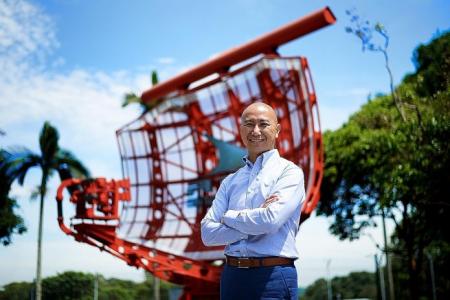Air traffic control officers: 'Absolutely no room for error'
The number of air traffic control officers looks set to rise from 390 now to about 600 by 2020. HARIZ BAHARUDIN (harizbah@sph.com.sg) visits their control centre to speak to one of them
His work station is alive with blinking lights, multiple computer screens and buttons in every colour.
Through it all, Mr Jason Lie Chin Ann, must remain focused.
If he is distracted, he might make a mistake. And air traffic control officers (ATCOs) cannot afford a mistake.
Using radar technology and navigational systems, Mr Lie, 41, and his colleagues guide and monitor planes going in and out of Singapore's airspace.
It is people like Mr Lie who give pilots the clearance to ascend, descend and land.
With a laugh, Mr Lie tells The New Paper on Sunday: "Contrary to what some believe, we don't just hold up ping pong paddles to wave at pilots to land."
NO IDLE CHIT-CHAT
Last year, ATCOs oversaw more than 650,000 air-traffic movements in the Singapore Flight Information Region (FIR) - a number that looks poised to hit a million by 2025.
Being responsible for people's lives might seem stressful, but Mr Lie says it is "all in a day's job".
He says: "There is no idle chit-chat and no loud sounds. We can't even use our phones while we are on shift.
"When we're on duty, all of us are focused, and there are no distractions."
Each shift lasts nine hours. There are three shifts - morning, afternoon and night - in a five-day work week. But the controllers do not spend all nine hours working.
Every two hours, Mr Lie gets a half-hour break, which is important for "decompression and to centre oneself".
Some ATCOs use the time to grab a quick bite or drink coffee, while others watch television in the pantry or play games like foosball.
Mr Lie says: "It is time for you to let go for a bit and do whatever you want before you return, ready to be 100 per cent focused."
At any given time at the air traffic control tower at Changi Airport, Mr Lie says there are about nine ATCOs monitoring the airspace and providing the go-ahead for planes.
BREAK
"Having people around means we can still go for a toilet break, as long as it is quick," he chortles.
But ATCOs do not just work at Changi Airport.
Officers at the Singapore Air Traffic Control Centre (SATCC) near Loyang Avenue also watch the FIR, while those posted to the Seletar Airport provide aerodome control service to aircrafts there.
Although there are no windows in the SATCC, all eyes are constantly on the sky. When TNPS paid a visit to the control centre on Friday, there were more than 20 terminals feeding information about the goings-on in Singapore's FIR.
"Not many people know that the Singapore FIR approaches 800,000 sq km, it is not just what is going on directly above," explains Mr Lie.
"It is a big area, and we've got to make sure we keep watch."
In addition to their duties in the control rooms, some, like Mr Lie, also instruct trainees at the SATCC.
In order to get selected as an ATCO, applicants must be Singapore citizens, possess a tertiary qualification and pass a series of aptitude and voice tests.
Recruits are trained for around four years before they are deemed fit for operation.
"Anything can happen in the skies," says Mr Lie.
Their rigorous training includes procedures on what to do during disasters, medical complications and even emergencies like fires.
He shares that ATCOs respond to emergency and can let a plane land earlier, should the need arise.
For instance, if a pregnant passenger goes into labour, the ATCO can bump up the plane's queue number for landing and give it priority.
Although Mr Lie has not experienced many of these situations yet, he shares that his job is most challenging when there is bad weather like heavy rain or strong winds.
He says: "There is absolutely no room for error because people's lives are on the line."
"Winds and rain can cause the planes to be unpredictable, so we're trained to always be adaptable."
And the perks?
Mr Lie says: "When you're up in the control tower, it is really a great view. We get the best sunrise of Singapore."
Shortage of controllers globally
The need for more air traffic controllers is being felt not only in Singapore but globally. It is a big enough problem to cause the United Nations (UN) some concern.
The worry is that the current number of controllers will not be enough to handle the soaring number of passengers.
In 2011, the UN's civil aviation arm, the International Civil Aviation Organisation (ICAO), estimated that over 40,000 air traffic controllers will be needed worldwide by 2030.

And in that time, it is expected that the number of people flying will double in the next two decades to a whopping 7 billion, says the International Air Transport Association.
While Asia is the fastest growing travel market, there are so few training facilities in the region that ICAO estimates there will be a deficit of more than 1,000 controllers.
There are 390 ATCOs here and the number will hit about 600 by 2020, says the Civil Aviation Authority of Singapore (CAAS).
But with two new airport terminals set to open at Changi Airport by 2025, there is a need for even more air traffic controllers.
By then, more than a million flights each year are likely to come through the airspace here, nearly double the 650,000 air traffic movements recorded last year.
CAAS says the number of planes moving in and out of Changi Airport each hour will increase from 68 now to more than 100 flights "in the coming years".
Currently, any Singaporean with a tertiary qualification can apply to be an ATCO and CAAS provides the training.
DEMAND
But an academic course may be needed to meet impending demand, says Mr Abbas Ismail, course manager for the diploma in aviation management & services, School of Engineering at Temasek Polytechnic.
He says a specific ATC course can provide a steady pipeline of candidates for the CAAS.
"One way the industry could increase the number of ATCOs is by teaming up with educational institutions to develop a specialised training program for ATC, providing them (the candidates) with a job and sponsoring their university education after a few years," he adds.
ATCOs must also be provided with a more structured career path, says Mr Abbas.
Says a CAAS spokesman: "CAAS conducts regular reviews of ATCO work, career progression and benefits to ensure that it continues to offer an attractive career value proposition and competitive remuneration."
Get The New Paper on your phone with the free TNP app. Download from the Apple App Store or Google Play Store now



